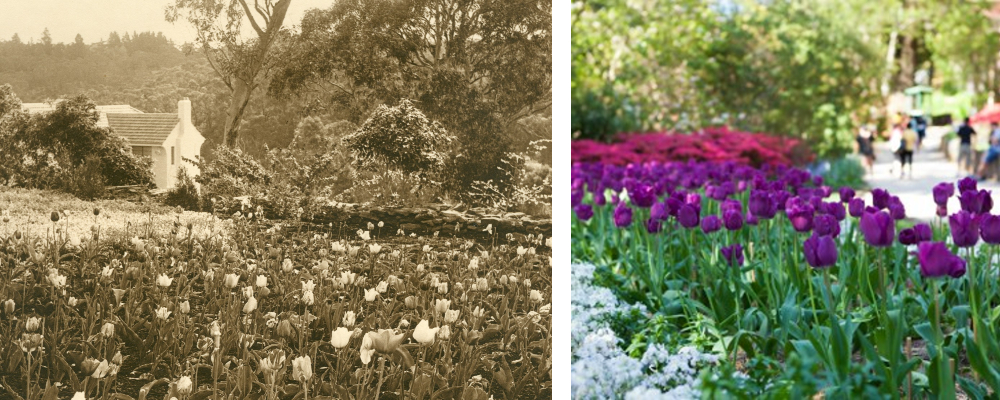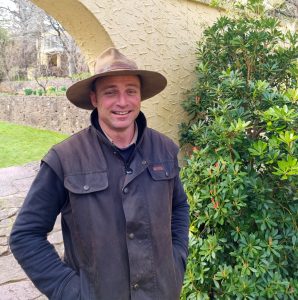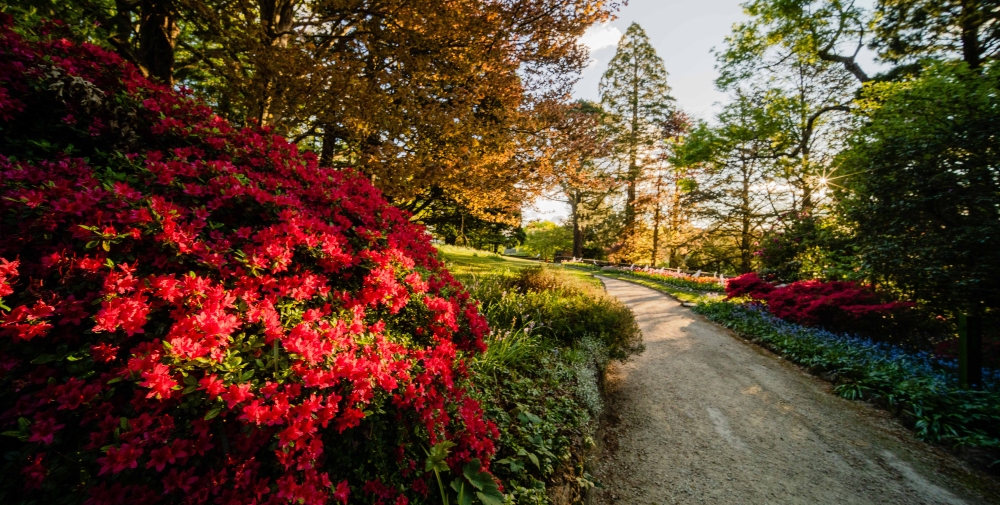What goes into looking after a heritage garden in spring? Head Gardener at Everglades House & Gardens, Simon Cooper, takes us behind the scenes to reveal his sustainable planting techniques and the major jobs of the season.
Early spring brings a flowering frenzy to Everglades House & Gardens. The Japanese cherry trees are pink with blossoms, the Lilac Terrace is a sea of purple lilacs, and the local ducks and cockatoos are out in force. The gardeners are also getting ready for one of their busiest times of the year.
Flower patrol
The gardens at Everglades were built for Henri Van de Velde in the 1930s by Danish-born landscape gardener Paul Sorensen. He had a talent for mixing native and exotic plants, and managed to transform over five hectares of dense Blue Mountains bushland into one of Australia’s most spectacular examples of inter-war garden design.
While gardening trends have changed over the decades, the team at Everglades House & Gardens maintain the property’s natural heritage by planting annuals and perennials that would have been around in the 1930s and 40s.
Tulips were a feature of the original garden. These days, Simon says they begin planting out the famous tulip bed every May so they’re ready to flower in October. However there are vandals to watch out for in the tulip bed.
“The cockatoos fly down and nip off all the flowers,” he explains. “We have to net the tulips to keep the cockatoos out of them. They’re absolute vandals.” Simon takes the nets off towards the end of September, then puts stick deterrents around the tulips to keep the cockatoos away. “The ducks also like to wander through and eat the seedlings,” he laughs. “The spring garden requires a lot of pest control.”

With a 90-year history behind it, the gardeners at Everglades work to a precise Conservation Management Plan, which protects the property’s natural heritage and gives visitors a unique glimpse into plants of the past.
But like any garden, things are always changing. “The challenge is the garden would have had a lot more sun back in its early days,” explains Simon. “Now we have more mature trees like Cedrus atlanica ‘Glauca’ Blue Atlantic Cedar, and Quercus rubra Red Oak, which create more shade and can limit what we put in. As the garden evolves some heritage plants are no longer suitable and need to be replaced with something else that’s of the period of the garden. Also any repairs like rock walls or paths need to be done to the correct heritage standards. It’s a challenge, but always interesting to learn the way things were done 90 years ago and to come up with solutions to any difficulties.”
Staying sustainable

Other than the cockatoos, there are the other usual garden pests that need to be controlled, like snails, aphids and never-ending weeds.
National Trust property Retford Park has led a transition away from the use of chemicals, and the gardeners at Everglades have taken up a similar chemical-free approach, showing that even a large scale heritage garden can be managed using sustainable gardening practices.
“Where possible we try not to use chemicals for weed and pest control,” says Simon. “For soil pathogens I’ve introduced beneficial fungus into the gardens to give it some resistance to disease and restore balance back to the soil. It’s cheaper and reduces the amount of pesticides we have to use in the garden. It also increases the health of the soil and plants.”
Almost all green waste generated in the garden is also composted and re-used in the garden, helping to lower landfill and improve the garden without buying in material.
Never a dull moment
Everglades is made up of a series of garden ‘rooms’ that Sorenson envisioned for the property. There’s the Asian-inspired Glades filled with maples and Harlequin flowers, the Cherry Terrace lined with weeping cheery trees, and even a fern-filled Grotto.
Lately Simon has been tackling the Alpine area. “We had azaleas up in the alpine area which hadn’t had a hard prune for many years. You couldn’t even get in there. We pruned them down to a metre, and they should be flowering into big azalea drifts in the coming years.”
The hard work has continued this spring, with 600 primulas planted in the Lilac Terrace, and countless hours of hand weeding in the garden beds to avoid spraying herbicides. Simon says he couldn’t do it without his hard-working assistant gardener Serge Dos Santos, and the eight volunteers who donate their time to help in the garden.
“The volunteers are the unsung heroes of this garden. They each do a few hours on different days, and they’re a huge help.”

Spring is special
After a long Blue Mountains winter, the gardeners at Everglades are keen to open the gates to visitors. “Ït’s their reaction that makes it all worth it,” says Simon. “The thing I like most about the garden in spring is that people come in and see everything in bloom and say ‘wow it looks great.’ They also ask lots of questions, which is really rewarding as a gardener. It’s great to see all the hard work put in by everyone pay off with a beautiful garden and happy people enjoying it.”
Plan a day trip to Everglades House & Gardens.
Explore our other heritage gardens this spring.
Sign up to the free National Trust (NSW) newsletter for more spring updates, news and events.

 Twitter
Twitter Facebook
Facebook Linkedin
Linkedin Email
Email